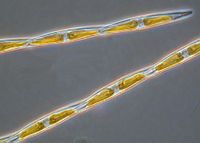
Industrial and natural compounds in filter-feeding black fly larvae and water in 3 tundra streams.
Sign Up to like & getrecommendations! Published in 2018 at "Environmental toxicology and chemistry"
DOI: 10.1002/etc.4267
Abstract: We report concentrations of polychlorinated biphenyls, polybrominated diphenyl ethers, novel flame retardants, and naturally occurring bromoanisoles in water and filter-feeding black fly (Simuliidae) larvae in 3 tundra streams in northern Sweden. The results demonstrate that… read more here.
Keywords: feeding black; water; filter feeding; black fly ... See more keywords

Ecotoxicity of polyethylene nanoplastics from the North Atlantic oceanic gyre on freshwater and marine organisms (microalgae and filter-feeding bivalves)
Sign Up to like & getrecommendations! Published in 2019 at "Environmental Science and Pollution Research"
DOI: 10.1007/s11356-019-04668-3
Abstract: Each year, 5 to 10 million tons of plastic waste is dumped in the oceans via freshwaters and accumulated in huge oceanic gyres. Under the effect of several abiotic factors, macro plastic wastes (or plastic wastes with… read more here.
Keywords: north atlantic; freshwater; marine; exposure ... See more keywords

Effects of organic carbon addition on water quality and growth performance of bottom- and filter-feeding carp in a minimum-water-exchange pond polyculture system
Sign Up to like & getrecommendations! Published in 2018 at "Fisheries Science"
DOI: 10.1007/s12562-018-1204-7
Abstract: A 120-day evaluation was performed to determine the impacts of various carbon source supplements on the water grade and production of bottom- and filter-feeding carp inside a minimum-water-exchange system. The outcomes revealed that the overall… read more here.
Keywords: carbon; water; carbon source; filter feeding ... See more keywords

Morphological reflections of evolutionary adaptations in the tongue of the white-headed duck
Sign Up to like & getrecommendations! Published in 2018 at "Anatomical Science International"
DOI: 10.1007/s12565-018-0438-x
Abstract: During an organism’s evolution, functional adaptations help species to become better suited to their ecological niches. From the morphological aspect, these adaptations are reflected in the anatomical specializations of different organs. Specializations of the lingual… read more here.
Keywords: microscopy; filter feeding; white headed; cartilaginous skeleton ... See more keywords

Stranded whale shark (Rhincodon typus) reveals vulnerability of filter-feeding elasmobranchs to marine litter in the Philippines.
Sign Up to like & getrecommendations! Published in 2019 at "Marine pollution bulletin"
DOI: 10.1016/j.marpolbul.2019.02.030
Abstract: Marine litter has adversely affected many marine species. However, information on its impacts on filter-feeding elasmobranchs (such as the whale shark, Rhinocodon typus) is scarce. The Philippines is an essential habitat for whale sharks, and… read more here.
Keywords: whale shark; marine litter; filter feeding; marine ... See more keywords

Efficiency of sympagic-benthic coupling revealed by analyses of n-3 fatty acids, IP25 and other highly branched isoprenoids in two filter-feeding Arctic benthic molluscs: Mya truncata and Serripes groenlandicus
Sign Up to like & getrecommendations! Published in 2020 at "Organic Geochemistry"
DOI: 10.1016/j.orggeochem.2020.104160
Abstract: Abstract The aim of this work was to determine the impact of sympagic (ice-associated) algal primary production on the quality of Arctic filter-feeding bivalves. For this purpose, we investigated the sea ice production of lipids… read more here.
Keywords: sea ice; production; fatty acids; filter feeding ... See more keywords

CFD-DEM simulation of the hydrodynamic filtration performance in balaenid whale filter feeding
Sign Up to like & getrecommendations! Published in 2021 at "Science of The Total Environment"
DOI: 10.1016/j.scitotenv.2021.147696
Abstract: Abstract Solid-liquid separation is a key link in environmental chemical and process engineering, including water purification, pollution treatment, etc. Traditional industrial filters are often clogged and damaged because they cannot be cleaned or replaced in… read more here.
Keywords: shape; filter feeding; filtration; balaenid whale ... See more keywords

Palaeohistology reveals an unusual periodontium and tooth implantation in a filter-feeding pterodactyloid pterosaur, Pterodaustro guinazui, from the Lower Cretaceous of Argentina.
Sign Up to like & getrecommendations! Published in 2023 at "Journal of anatomy"
DOI: 10.1111/joa.13878
Abstract: Pterosaurs are an extinct group of Mesozoic flying reptiles, which exhibited high diversity with regard to their dentition. Although morphological features of pterosaur dentition have been described in detail in several contributions, the histology of… read more here.
Keywords: pterodactyloid pterosaur; pterodaustro guinazui; feeding pterodactyloid; filter feeding ... See more keywords

The combined effects of filter-feeding bivalves (Cristaria plicata) and submerged macrophytes (Hydrilla verticillate) on phytoplankton assemblages in nutrient-enriched freshwater mesocosms
Sign Up to like & getrecommendations! Published in 2023 at "Frontiers in Plant Science"
DOI: 10.3389/fpls.2023.1069593
Abstract: Freshwater ecosystems are threatened by eutrophication, which causes persistent and harmful algal blooms. Filter-feeding bivalve mollusks and submerged macrophytes (SMs) alleviate the eutrophication effects by inhibiting phytoplankton biomass blooms. However, very little is known about… read more here.
Keywords: phytoplankton assemblages; freshwater; phytoplankton; feeding bivalves ... See more keywords

Interactions between Filter-Feeding Bivalves and Toxic Diatoms: Influence on the Feeding Behavior of Crassostrea gigas and Pecten maximus and on Toxin Production by Pseudo-nitzschia
Sign Up to like & getrecommendations! Published in 2021 at "Toxins"
DOI: 10.3390/toxins13080577
Abstract: Among Pseudo-nitzschia species, some produce the neurotoxin domoic acid (DA), a source of serious health problems for marine organisms. Filter-feeding organisms—e.g., bivalves feeding on toxigenic Pseudo-nitzschia spp.—are the main vector of DA in humans. However,… read more here.
Keywords: pseudo; filter feeding; gigas; production pseudo ... See more keywords